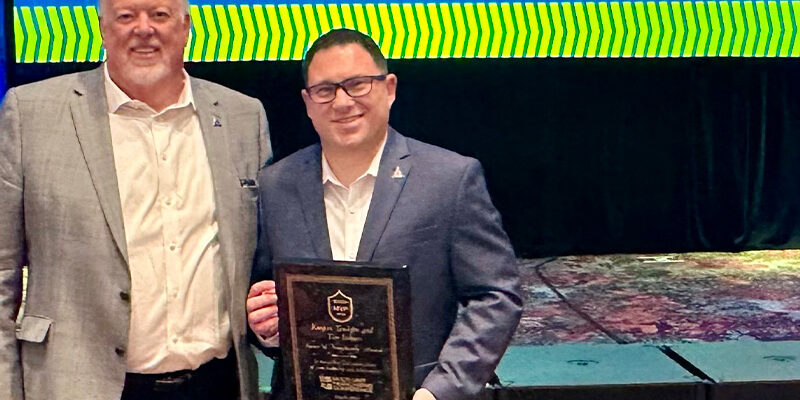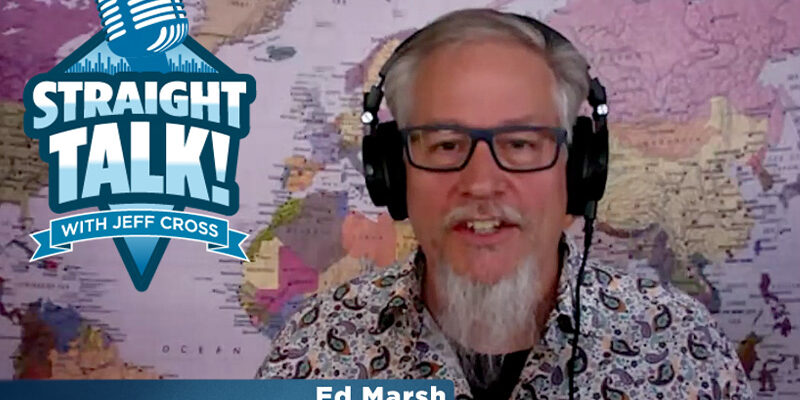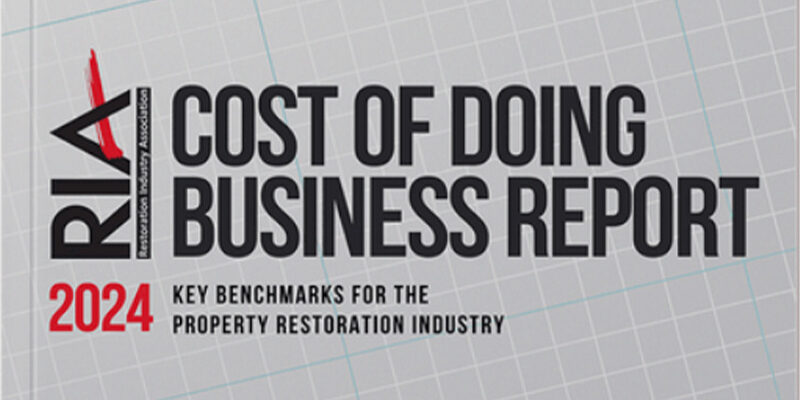The Greatest Need—Part One

By Mark Springer
No matter where you go or who you talk to, wherever two or more restorers are gathered, the tone will likely be a bit terse. As the industry undergoes ever faster changes, some of the “old-timers” are beginning to feel that it might be time to cash in their chips and sell their businesses. A leading business consultant who works with some of the largest corporate firms in the world, Donald Cooper, says, “The human brain is wired for negativity.” While this condition might explain some of the nervousness, it is clear that significant changes are on the horizon, and a restorer in the 21st century is facing a rapidly evolving landscape.
As restorers, this juncture presents a couple of options. The first would be to reactively accept the conditions, evolve with the industry, recalibrate, and refocus our efforts toward adaptation to these trends. Many of us have been doing this for years with less-than-satisfying results. The second option is to take a more proactive approach. This entails identifying the issues and their root causes, building a strategy to address the issues, and then uniting as an industry to speak to the issues and drive positive change.
As you may surmise, I am firmly in favor of the latter approach. The purpose of this article is to build a case for proactive, collective advocacy for the best interests of restoration companies. This won’t be an easy task. Hard work will be required, and the engagement of RIA contractor members will be critical to our success. I hope to detail a vision for a path that we can all embrace for the good of our businesses and the strength and sustainability of the property repair industry.
What is the problem?
In an article I wrote for the Restoration Industry Association’s (RIA) C&R journal (“Contractors: It’s Time to Take a Stand” from November/December 2018), I describe a situation in which an insurance carrier refuses any payment on a water mitigation claim due to a technicality in document upload. It is not my intent to relitigate that argument but rather to expand on some of the issues that restoration contractors face. That article’s thesis poses a somewhat grim outlook for the restoration industry; however, I continue to see challenges emerge that reinforce this position. The thesis is this:
“If restoration companies are unwilling to unite, advocate for sustainable claims practices, and take a proactive approach with insurance carrier claims policies, then the restoration industry as we know it will cease to exist within a decade.”
The “claims policies” I refer to go much deeper than the specific policies that a carrier dictates to issue payment. The issues we face are many, and they all impact the entire claims process that a property restoration company must navigate in the course of their day-to-day operations.
What follows are some examples of the challenges and threats we face. Realistically, each of these areas of concern is not only necessary, but essential in the claims environment. However, there are some key questions that each restorer, and the industry at large, should be examining if we are going be able to operate our businesses sustainably.
These questions are not rhetorical; they are not intended to be presented with sarcasm or bias. This isn’t a time for conspiracy theories, but we would be exceptionally naive if we were to think that the largest fiduciaries in the world, who incidentally are the repositories of the largest quantities of data in the world, were looking out for any interest other than their own and that of their shareholders.
Example 1: Pricing/scoping platforms
I’m not going to beat around the bush: Xactware and its parent Verisk are massive companies. Xactware’s main platform, Xactimate, is an incredible estimating and scoping tool, and when used as such, it can benefit the restorer in many ways. In fact, Xactimate was developed by contractors several decades ago. But how much do you know about Verisk?
Here are details for your consideration: Verisk is a publicly traded company with a market capitalization, at the time of this writing, of a little more than $19 billion. Verisk reports $2.1 billion in revenue per year, and their adjusted net earnings in 2017 were $630 million. That is a 29% net margin income. Keep this number in mind when you are defending a “10 and 10” overhead and profit argument.
Before they went public, Verisk Analytics Inc. was owned primarily by American International Group (AIG), Travelers Insurance, and The Hartford. When Verisk went public in 2009, it was the largest initial public offering (IPO) since Visa had gone public a year earlier in 2008. These insurance carriers were able to divest their ownership after the IPO. Verisk’s stock ownership is now largely diversified between mutual funds, insurance companies, exchange traded funds, and individual investors.
What is Verisk’s mission? Their website proclaims, “Verisk provides data analytic insights to customers in insurance, energy, and specialized markets and financial services to help them make better, faster, and more focused decisions that minimize risk and maximize value.”
While the published pricing methodology of Xactimate suggests a unique and scientific approach, many contractors (myself included) have experienced long-term stagnation of pricing, all while the experience in the marketplace is the opposite, with labor rates increasing rapidly. This reality should prompt restorers to grapple with the following questions:
- Does Verisk’s mission create an environment whereby pricing is suppressed unfairly for contractors?
- If we are comfortable with this environment, are we collectively comfortable with the methodology whereby this company sets pricing?
- Who is speaking to Verisk on behalf of contractors about their methodology, and is their approach fundamentally fair in its assumptions and calculations?
- What level of transparency does this company provide with respect to how it gathers data and sets pricing?
- What is Xactware hearing from contractors? Is it consistent? What are the repercussions for ignoring this voice?
Example 2: Consultant involvement for claim resolution
If you are working a “large loss,” the current trend is to be assigned a claims consultant. In a good scenario, this consultant is assigned on the front end of the claim, and the restorer, the carrier, and the consultant are able to agree on parameters that ensure the claim is handled efficiently.
However, this ideal scenario is often not the case. In many situations, a consultant is assigned to the claim after the mitigation is completed. The consultant is often dispatched from an area far from the location of the claim where market conditions may be very different from those where the damage has occurred.
Sometimes the approach of the consultant is immediately hostile, and sometimes it is belittling and demeaning. An endless and time-consuming cascade of requests for documentation, records, and other information soon follows. Many of these requests are well outside the scope of what any reputable business would offer their clients. In some cases, a consultant may demand that the contractor use a different billing style that is in direct conflict with the contract’s agreement with the customer.
To add more frustration, when one task is completed, many other requests immediately materialize. The contractor often taps out at some point and accepts a settlement at a fraction of the original invoice, whether that be a unit cost scope or a time and materials estimate. In either case, the documentation can be excellent, the transparency exceptional, and yet the settlement offer continues to be a fraction of the fully justifiable total that was earned by the restoration contractor. There are some questions to consider here:
- Are the time and resources spent on these unscheduled administrative requests simply “the cost of doing business,” or are they billable expenses to the total cost of the project?
- Should there be established ground rules for these interactions?
- Should consultants be expected to provide evidence of their qualifications to serve in any capacity on an insurance claim?
- Should a consultant be required to disclose their financial interest in successfully reducing the cost of the claim?
Example 3: TPA involvement and expanded influence
Technically, what we call a third-party administrator, or TPA, should more accurately be referred to as a contractor network, but for the sake of clarity, we’ll refer to these as TPAs. The expansion of TPAs continues at an incredible rate, and the reason for this is logical and predictable: Insurance carriers are focused on reducing loss adjustment expense and limiting claim severity. Field adjusters are costly and with drive time between claims, very inefficient.
The trend of carriers assigning claims through a TPA is likely going to expand significantly over the coming years; however, this expansion is increasing the pressure on restoration contractors disproportionately to the “opportunity.” At a recent contractor network annual conference, the message from the network leadership was clear: We need you to get your work done more quickly, provide more detailed documentation, increase customer Net Promoter Scores, and do all of this for less money. Some questions to consider involving TPAs are:
- What are TPAs hearing from contractors prior to negotiating contracts with carriers?
- Are TPAs conveying contractor concerns to carriers in good faith or with any sense of urgency?
- How can claim disputes be resolved in a way that honors the contractor’s integrity while still protecting the interests of the client, as the insured?
- Are TPA programs in alignment with accepted restoration industry best practices and published guidelines that have been established as the standard of care?
Example 4: Government regulations and rules, EPA lead-based paint requirements
On April 22, 2010, the EPA required firms handling renovation in homes, child care facilities, and kindergartens that were built prior to 1978 to have either state or EPA certification. The implementation of these rules heavily impacted the disaster repair industry, particularly in the arena of water mitigation where rapid response and often invasive demolition are required to prevent collateral damage from subsurface moisture. Restoration companies run by sound operators took these changes seriously, acquired certifications, retained records, and followed the required protocols. Unfortunately, many poor operators fly under the radar. Many may have wondered:
- As arguably the most impacted industry in the country, was our voice heard when the EPA made these changes?
- What exceptions are made for contractors in emergency mitigation efforts?
- Should the costs of implementing these programs be borne by the restorer, who is unable to recoup the cost within the current claims programs and carrier guidelines?
What is collective advocacy?
In all these cases, whether it be a pricing software, a claim consultant, a third-party claim administrator, or a government entity, I respect and understand the need for their place in our industry. Some restorers just want TPAs to go away, but that is extremely unlikely. All these market forces are here to stay. In fact, they are likely going to increase in their significance and influence on the industry. What I am not comfortable with, and what I don’t think any contractor in the property claims industry should be comfortable with, is the fact that we have virtually zero collective representation to any of these claim resolution stakeholders. Our voice is neither heard nor valued.
 Somewhat embarrassingly, we are part of the problem. Our voice is not heard or appreciated because we do not speak with collective unity and focus. Some of these individual entities may have a group of contractors on their advisory boards who counsel them on best practices, but their counsel is often fragmented and inconsistent. It could be argued that the worst voice for contractors is a single or small group of contractors. They often state, “I just can’t tell my contractor services network that this new policy is harmful because they might stop sending me claims.”
Somewhat embarrassingly, we are part of the problem. Our voice is not heard or appreciated because we do not speak with collective unity and focus. Some of these individual entities may have a group of contractors on their advisory boards who counsel them on best practices, but their counsel is often fragmented and inconsistent. It could be argued that the worst voice for contractors is a single or small group of contractors. They often state, “I just can’t tell my contractor services network that this new policy is harmful because they might stop sending me claims.”
Realistically, contractors have abdicated their voice to the TPA networks, which essentially speak on behalf of restorers to the insurance carrier community. Is this improving the landscape for the restorer? Are claims running smoother, more efficiently, and more profitably? Overall, the answer is no. Increasingly, contractors are reducing territory, seeking other claims sources, or trying to get out of TPA work entirely.
It’s time the restoration industry starts to speak for itself. As the restoration industry’s premier trade association, RIA should be the conduit for this voice. RIA is an association with an impressive history and pedigree. Trade associations typically advocate for their trade and their members. This is what we should be doing now and what we should have been doing for the past 74 years. It is counterproductive to discuss why we haven’t done this. What we can focus on at this point is the future—a future that can be better if we unite around this common goal for collective advocacy and move forward in a thoughtful and strategic manner.
I will lay out a step-by-step plan next month for how we can all come together and move forward as a cohesive unit for the betterment of the industry and every one of its hardworking members.
*This article previously appeared in C&R Magazine, Q1 2019.
Mark Springer, CR, is the CEO of Montana-based Dayspring Restoration. He serves as chair of the RIA’s education committee as well as a member of RIA’s board and executive committee. Email Springer with thoughts, feedback, and suggestions regarding this article at [email protected].












